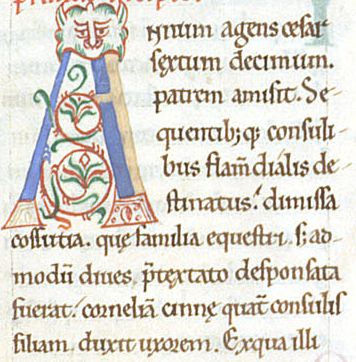|
|
 |
The
decorative initial A with a rather sad lion
looking as if he is choking on the letter, which is itself adorned with
foliate motifs, is a common motif around the 12th century. Given that there
are many positive and honourable characteristics that were attributed
to lions in the medieval bestiaries,
I have no idea why they drew them in such an uncomfortable situation. |
|
Note
the punctuation marks of a dot, or a dot and slash. Hyphens are present
when a word carries from line to line. Capital letters are used sparingly,
and not for the first letters of names. The majuscule
N in the second letter of annum at the beginning is a decorative rather than grammatical device. |
|
more
text  |
 previous page
previous page |
|
Suetonius
De Vita Caesarum, late 12th century (British
Library, Egerton 3055, f.2) All
images by permission of the British Library. Images are made available by the British Library under a Creative Commons licence. |
|
|
overview | text | alphabet
| abbreviations | exercises
| transcript
| translation
| |
|
Click
on each of the above to walk your way through a segment of the text. The
transcript will appear in a separate window so that you can use it for
reference at any time. These exercises are designed to guide you through
the text, not test you, so you can cheat as much as you like. |
|
 Script sample for this example Script sample for this example |
 Index
of Exercises Index
of Exercises |
 Index
of Scripts Index
of Scripts |
|
 |
 |